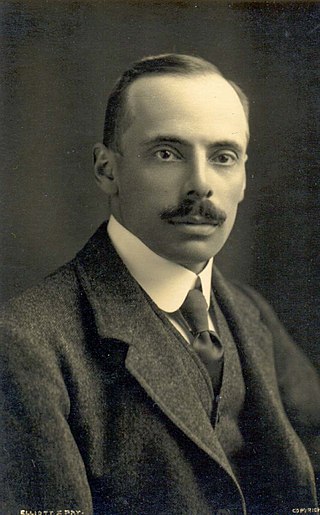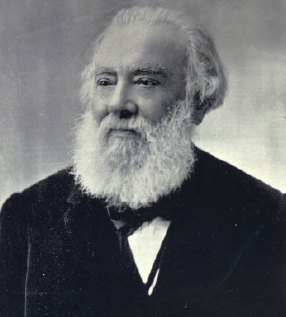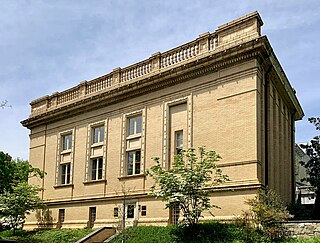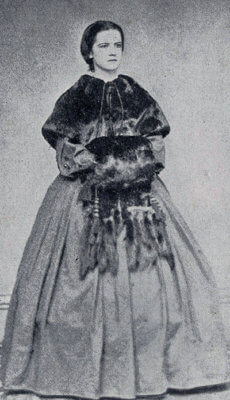
Alexander Graham Bell was a Scottish-born inventor, scientist and engineer who is credited with patenting the first practical telephone. He also co-founded the American Telephone and Telegraph Company (AT&T) in 1885.

Daniel Jones was a London-born British phonetician who studied under Paul Passy, professor of phonetics at the École des Hautes Études at the Sorbonne. He was head of the department of phonetics at University College London.
In phonology and linguistics, a phoneme is a set of phones that can distinguish one word from another in a particular language.
A vowel is a syllabic speech sound pronounced without any stricture in the vocal tract. Vowels are one of the two principal classes of speech sounds, the other being the consonant. Vowels vary in quality, in loudness and also in quantity (length). They are usually voiced and are closely involved in prosodic variation such as tone, intonation and stress.

The photophone is a telecommunications device that allows transmission of speech on a beam of light. It was invented jointly by Alexander Graham Bell and his assistant Charles Sumner Tainter on February 19, 1880, at Bell's laboratory at 1325 L Street in Washington, D.C. Both were later to become full associates in the Volta Laboratory Association, created and financed by Bell.

Shorthand is an abbreviated symbolic writing method that increases speed and brevity of writing as compared to longhand, a more common method of writing a language. The process of writing in shorthand is called stenography, from the Greek stenos (narrow) and graphein. It has also been called brachygraphy, from Greek brachys (short), and tachygraphy, from Greek tachys, depending on whether compression or speed of writing is the goal.
Phonetic transcription is the visual representation of speech sounds by means of symbols. The most common type of phonetic transcription uses a phonetic alphabet, such as the International Phonetic Alphabet.

A spectrogram is a visual representation of the spectrum of frequencies of a signal as it varies with time. When applied to an audio signal, spectrograms are sometimes called sonographs, voiceprints, or voicegrams. When the data are represented in a 3D plot they may be called waterfall displays.
Acoustic phonetics is a subfield of phonetics, which deals with acoustic aspects of speech sounds. Acoustic phonetics investigates time domain features such as the mean squared amplitude of a waveform, its duration, its fundamental frequency, or frequency domain features such as the frequency spectrum, or even combined spectrotemporal features and the relationship of these properties to other branches of phonetics, and to abstract linguistic concepts such as phonemes, phrases, or utterances.

The invention of the telephone was the culmination of work done by more than one individual, and led to an array of lawsuits relating to the patent claims of several individuals and numerous companies.

Alexander Melville Bell was a teacher and researcher of physiological phonetics and was the author of numerous works on orthoepy and elocution.
A pronunciation respelling for English is a notation used to convey the pronunciation of words in the English language, which do not have a phonemic orthography.
The Elisha Gray and Alexander Graham Bell controversy concerns the question of whether Gray and Bell invented the telephone independently. This issue is narrower than the question of who deserves credit for inventing the telephone, for which there are several claimants.

Alexander Graham Bell honors and tributes include honors bestowed upon him and awards named for him.

The Volta Laboratory and the Volta Bureau were created in Georgetown, Washington, D.C., by Alexander Graham Bell.(19/20th-century scientist and inventor best known for his work on the telephone)

A writing system is a method of visually representing verbal communication, based on a script and a set of rules regulating its use.

The Bell Homestead National Historic Site, located in Brantford, Ontario, Canada, also known by the name of its principal structure, Melville House, was the first North American home of Professor Alexander Melville Bell and his family, including his last surviving son, scientist Alexander Graham Bell. The younger Bell conducted his earliest experiments in North America there, and later invented the telephone at the Homestead in July 1874. In a 1906 speech to the Brantford Board of Trade, Bell commented on the telephone's invention: "the telephone problem was solved, and it was solved at my father's home".

Professor David Charles Bell, was a Scottish-born scholar, author and professor of elocution. He was an elder brother to Alexander Melville Bell and uncle to Alexander Graham Bell.

Caroline Ardelia Yale was an American inventor and educator who revolutionized the teaching of hearing-impaired students. A collaborator of Alexander Graham Bell, her phonetic system became the most widely used in America. She worked most of her career at the Clarke School for the Deaf, eventually becoming Principal of the institution, and was involved in raising funds for the deaf through leading figures such as her childhood friend, Grace Coolidge, First Lady of the United States. She was also director and cofounder of the Alexander Graham Bell Association for the Deaf and Hard of Hearing.
Phonetics is a branch of linguistics that comprises the study of the sounds of human speech.














